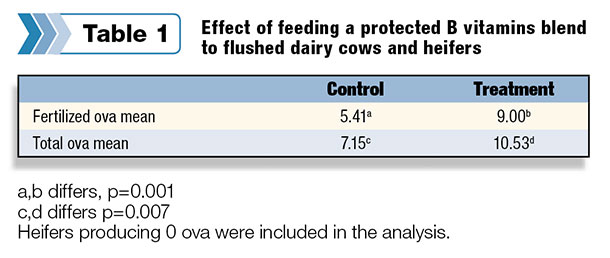Embryo transfer has evolved since its inception in North America in the early 1970s. Today, it is a worldwide, established industry focusing on genetic improvement, with more than 500,000 dairy and beef embryos being transferred annually. North America contributes to 46 percent of those embryo transfers.
Nutrition management is a key factor in determining the success or failure of the commercial transfer program. Donor cows can be reproductively impacted from energetic deficiencies, and postpartum management is critical for future breeding.
Vitamin and mineral deficiencies can also have a profound effect on reproductive performance. Heifer management and nutrition also needs careful consideration. Nutrition should be formulated to optimize the supply of nutrients to meet requirements.
Recently, focus on reproduction benefits gave more attention to B vitamins. Research indicates an important role for B vitamins in energy metabolism during early lactation, consequently improving energy balance and furthermore indicating cows confirmed pregnant earlier, showing reproductive success.
In a recent nutrigenomic study, folic acid and B12 were injected weekly to multiparous cows from 21 days pre-calving to 63 days post-calving. The dominant follicle was retrieved at day 57, and the follicular liquor was measured as an indication of its size. The supplemented cows had a larger dominant follicle than the control group (P=0.009).
Expression of the various gene transcripts were also measured and showed that the supplemented cows had a significantly higher concentration of RNA abundance for gene transcript involved in ovulation than the control group. The authors concluded that the dominant follicle of the cows supplemented with folic acid and B12 were larger and prepared for ovulation earlier than the control group.
To further investigate, dietary supplementation of a protected B vitamins blend (choline, riboflavin, folic acid, calcium pantothenate, pyridoxine and biotin) was tested in a commercial field trial in 2012 to evaluate its effect on the number of collected ova when heifers and cows were flushed.
The results compared 46 flushes from non-supplemented animals to 45 flushes from supplemented animals. The protected B vitamins blend was fed for a period of 21 days prior to flush to the treated animals. Table 1 reveals total and fertilized ova were significantly increased as a result of feeding the protected B vitamins blend prior to flush.

The quality of fertilized ova was also evaluated on one farm, with the results showing a 13.8 percent improvement in the number of grade A (excellent) when animals were supplemented with the protected B vitamins blend compared to non-supplemented animals.
Dairy cow fertility has been declining since the mid-1980s, and pregnancy rates are commonly lower than desired. Embryo production per superovulation and pregnancy rates have changed little over the last several years except that we have increased our ability to control ovarian function and collect embryos more frequently. Improvements in this area can have significant economic impact on farm profitability.
Nutritional manipulation, specifically the addition of protected B vitamins provided to animals prior to flush, is proven to increase the number of collected fertilized embryos, increasing the reproductive potential and improving economic gain.
For fertilized embryos valued at $800 per embryo, a result of one more embryo per flush has a great impact on reproductive performance and profitability, resulting from a slight change in the feed formulation. This recent research further indicates the important role of the protected B vitamins on reproductive success. PD
Angela Lipka is the Canadian ruminant product manager for Jefo.
References omitted due to spacebut are available upon request. Click here to email an editor.

Hélène Leclerc
Technical Supportand R&D
Jefo






